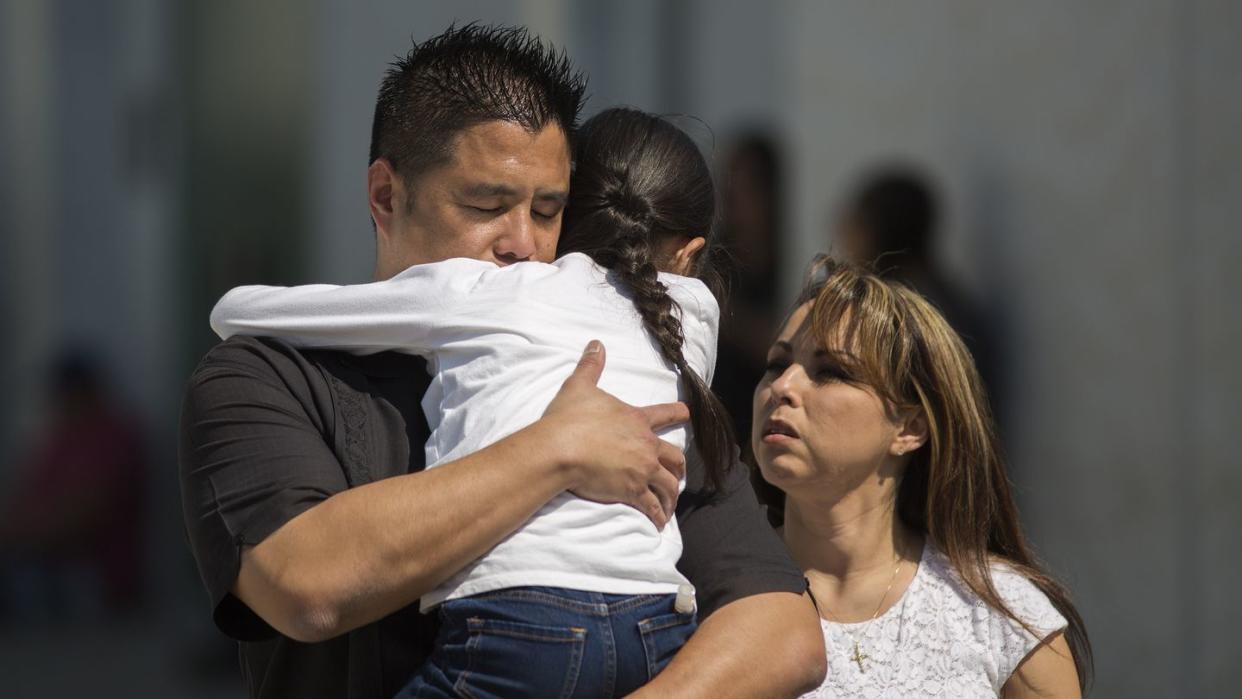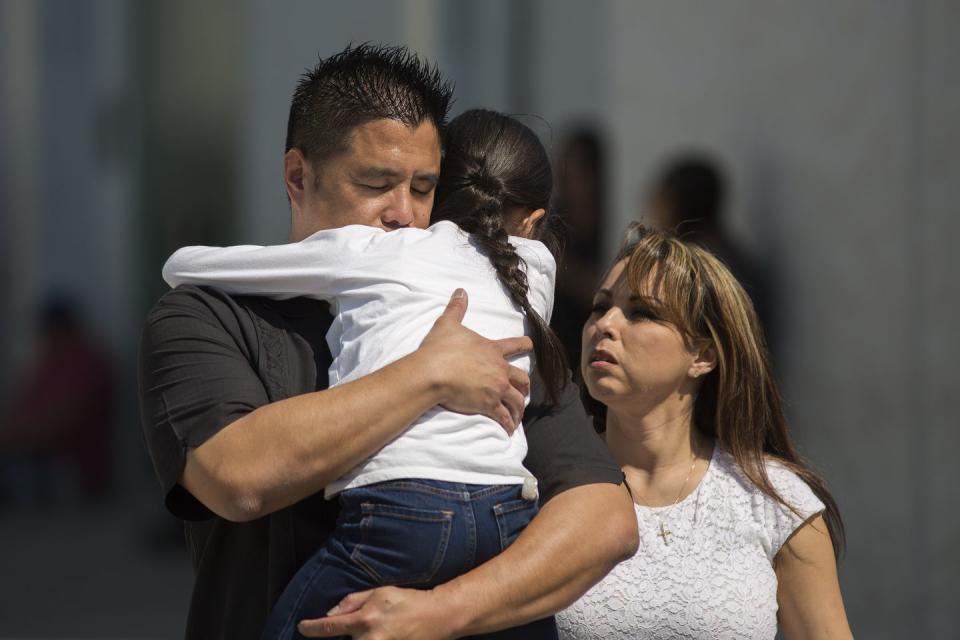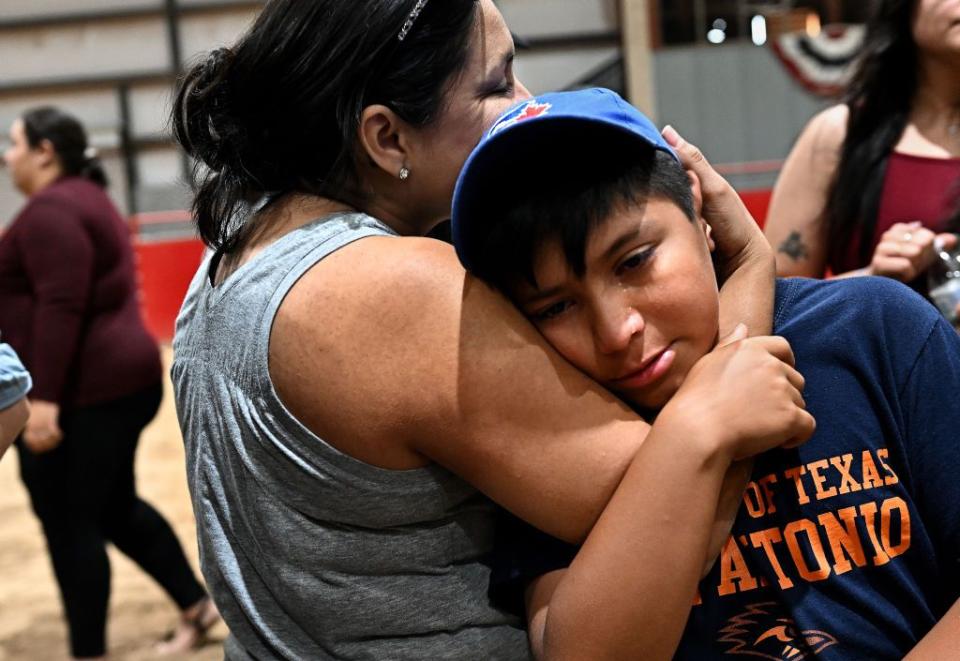Parenting in the Time of School Shootings


It’s Wednesday morning, the day after the horrific murder of nineteen schoolchildren and two teachers in Uvalde, Texas. My wife and I are standing outside our six-year-old’s school, willing ourselves to let him go in. We’re checking his mask, repositioning his backpack. I run a finger across the bridge of his nose, tracing its shape. She tucks stray hairs behind his ear. We hug him, a hug that I didn't want to end. He finally squirms away and goes in. There’s a stony silence among the parents left standing outside, each one wrecked at the impossibility of sending our children to school. Each one haunted by the same question: will they come back out?
A decade earlier, a different child. It was a gray December day. The schoolyard was filled with parents, silent, standing like ghosts. The Sandy Hook shooting had unfolded in Connecticut while our children were in school outside Chicago, safe by a thousand miles, but it didn't matter. Everyone had come early to pick up their children, to be there when the bell rang, to make sure they were OK. Of course they were OK—we knew. But we didn't know. We held our children when they came out, blinking in the dreary light of winter, confused as to why they were being held so long. We didn't want to tell them.
Our older son was seven when a gunman killed 20 children at Sandy Hook Elementary. He's 17 now and has just completed his first full year of in-person high school, having had his freshmen year cut short by Covid and his sophomore year spent entirely on Zoom. Halfway through this "back to normal" year, two kids with guns were discovered in a school bathroom. He spent two terrifying hours locked in his Japanese class, texting furiously with his mom and me. Two hours that felt like days. Years. We were standing outside before they were given the all-clear; we held him close when he finally came out.
In the decade between the two massacres, Sandy Hook in 2012 and Ulvade last week, there were more school shootings than I can remember. That's how it is now: we have a threshold for children being ripped apart by ammunition. You remember the big ones—Columbine, Sandy Hook, Parkland, Uvalde—but so many pass nearly undetected. That is, unless it happens to you. Then you never, ever forget, forever plunged into a bottomless pit of grief.
This is no way to live, and yet this is how we live. Every parent playing the worst lottery. Every parent pulling a slot machine whose jackpot pays off in a torrent of blood.
For parents in Uvalde, that time was last week. Their children ripped from them unexpectedly, traumatically, needlessly. The details have been meted out in horror-inducing slow-motion. The official story changes on a near-daily basis. What we know is a nightmare. The police left children to die for over an hour, harassing parents outside the school who were attempting to rush in themselves, to do what the police would not. Inside the classroom where the gunman had locked himself, the children left alive lived through a nightmare they may never fully escape.
I do not believe in God, but I know now there is a hell, and it is spending 78 minutes in a locked classroom with a gunman, smearing your dying friends' blood on yourself so you can pretend to be dead while whispering to the cops on your murdered teacher's phone. Cops who won’t come, despite being just feet away.

What the cops in Uvalde did is unforgivable but if, in the aftermath of last week’s slaughter, all we focus on is their inaction then we have already failed the next set of kids who will be sacrificed to the Second Amendment. Because this isn't about the circumstances of a single shooting, but about a never-ending hail of bullets that have torn our children apart for decades and the inaction—not of the cops, but of our lawmakers—to do anything to stop it.
In the decade between Sandy Hook and Uvalde nothing has fundamentally changed at the federal level in regards to the ability to purchase weapons powerful enough to tear a child into pieces in seconds. Lawmakers have tried on occasion and failed every time. According to the Gun Violence Archive, more than 3,500 mass shootings have taken place in the ten years between the two school massacres. hey are in our schools, our grocery stores, our churches, our doctors' offices, our streets, everywhere. The scar of mass gun death cuts across every inch of this country. No body count seems like it is big enough for action.
President Biden went on TV this week and, in an address from the White House, plead for action from Congress. He begged for an assault rifle ban, for a reduction in magazine sizes, for a ban on untraceable ghost guns. But even as he asked for it, you could tell he knew that inaction would win the day. There are senators meeting this week, while the rest of their colleagues enjoy a holiday off, optics that seem impossible to have allowed. The bipartisan group is lead by Democratic Senator Chris Murphy, who last week took to the Senate floor and asked for “ten Republicans that will vote for something.” He got four. The group will whittle around the edges of action, perhaps closing some background check loopholes or creating a federal “red flag” warning system. Whatever half-measures Murphy’s group comes up with still face long-shot odds to overcome the 60-vote filibuster that two Democrats refuse to dismantle for anything, including dead kids.
We all know what should be done, but few in power are willing to say it: Guns like the ones used by nearly every mass-shooter in America simply should not exist. Melt them down and make a monument to the dead from the molten steel.
We hadn’t told our youngest son about the Uvalde shooting when we dropped him at school the day after it happened. The full horror of it all was still sinking in, and it felt too hard to try and breach with a six-year-old at that moment. Instead, he found out at school, from another kid who told the whole class. His teacher had to clean up the mess. She emailed all the parents to let us know, because that’s what teachers do: everything. We knew that we had to explain it to him when he came home and desperately tried to figure out how to find the words. When we finally brought it up with him, he refused to talk. Finally, after agonizing minutes, he burst into tears. "It's just too sad," he wailed. All we could do was hold him and say yes.
Being a parent is a lot of things: This week it was heartbreaking, others it is tiring, frustrating, funny, surprising. Above all, it is an act of hope. Hope that the world will be better for your child than it was for you, that their opportunities will be boundless. Hope has been hard to find lately.
“Hope is a discipline,” activist Mariame Kaba says. In the days since the shooting, I have struggled to keep a grasp on that discipline, as I hold my children close, trying to keep alive the belief that the world can be better for them, even while I know for the nineteen children in Uvalde and for the hundreds that came before them, and the many more that will follow, it is not. And yet hope is all we have, as parents and as citizens in a country whose leaders can’t be motivated to action by the slaughter of children in their classroom. We’ll use some of that hope to do what we can to demand real change and use the rest to try and shield our children as best we can from the reality that it may never come.
You Might Also Like
